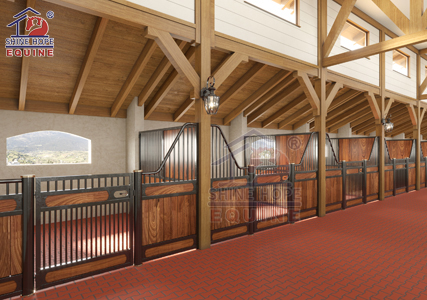
Many horseman feel confused and unsure: What horse stall design is the right choice? What horse stall styles are popular? How do i pick a correct horse stall type? This article aims to help providing some advice and guidance to help you make the right selection.
We will analyze through various dimensions as below, hoping to be helpful to you.
Horse Stall Features
Horse Stall Structure Style
Horse Stall Using Purposes
Horse Stall Surface Treatments

Horse Stall Hinged Door are the most common design for horse stalls and represent classic and traditional.
l Easy operation: Sturdy and smooth door hinges make it easy to open and close.
l Cost-effective: Hinged doors are more economical than sliding doors.
l Easy installation: Hinged doors are very easy to install, just fix the door with hinges.
l Adjustability: For non-standard sizes, the length of the door hinge can be adjusted to fit the size of the door frame.
l Space limitations: Since hinged doors need to open outward, there must be enough space in front of the aisle. Not suitable for narrow spaces.
l Potential accidents: Unlike sliding doors that have fixed tracks and fixtures, if hinged doors are not properly secured after opening, accidents can easily occur if they are bumped by horses or blown by the wind.
Horse Stall sliding doors are becoming an increasingly popular choice:
Advantages:
l Space-saving: Sliding doors slide along the top track, opening and closing without space restrictions.
l Smooth sliding: Sliding doors operate smoothly within the track with the help of two hanging rollers at the top.
l Easy operation: Opening and closing sliding doors is relatively simple and effortless, requiring minimal force.
l Slightly higher price: Compared to hinged doors, sliding doors have higher manufacturing costs.
l Size limitations: Sizes are relatively fixed and cannot be adjusted.
l Installation costs: Installation costs are slightly higher than hinged doors, requiring more labor.

Horse Stalls can be divided into two types based on their structure: semi-open horse stalls and fully closed horse stalls:
A semi-open horse stall allows horses place head outside easily which for better communication and interaction.
l European Design: The style resembles European design, giving it a classic appearance.
l Cost-Effective: Considering material and labor costs, semi-open stables are more cost-effective than fully enclosed ones.
l Social Interaction: Semi-open stables allow easier communication and interaction. Horses can reach out to interact and communicate.
l Horse Limitation: Semi-open stables are suitable for relatively gentle horses that are conducive to communication.
l Isolation Effect: The isolation effect is poor, posing a risk of jumping out or collisions, especially for spirited or breeding horses.
The full closed horse stall can provide a comfortable and secure environment for horses. Horses have a good rest and living comfortably in horse stalls.
l Effective Isolation: The fully enclosed design provides a higher level of isolation, effectively protecting the safety of the horses.
l Horse Management: Fully enclosed stables allow better management and control of the horses.
l Increased Safety: Being fully enclosed reduces interaction with the external environment, decreasing the risk of injury.
l High Construction Cost: Material and labor costs are higher compared to semi-open stables.
l Reduced Social Interaction: The fully enclosed environment reduces interaction and communication among horses.

According to end using, they are classified into Permanent Horse Stalls and Portable Horse Stalls.
Permanent horse stalls are typically constructed from sturdy and durable materials. Once installed, they are usually not dismantled or moved, ensuring safety and long-term use.
Permanent horse stalls provide horses with a solid and secure room. Horses can live healthily and happily inside them. These stalls are equipped with professional equipment and facilities, ensuring comprehensive care and attention to the horses.
Portable horse stalls are temporary facilities provided for horses for short-term or temporary purposes. They are mostly used for horse shows, horse events, horse competitions, and horse exhibition, etc.
The key feature of portable horse stalls is their simple assembly and convenient disassembly. They are lightweight yet sturdy enough for installation, disassembly, and transportation. Portable horse stalls are typically made of plastic materials such as PVC fabric, knife-scraped fabric, and HDPE panels.

According to surface treatment, there are two methods: hot-dip galvanizing and electrostatic powder coating.
Horse Stalls In Hot Dip Galvanizing Finish:
Hot-dip galvanizingis the most common anti-corrosion and rust-resistant surface treatment method. Horse stables treated with hot-dip galvanizing comply with the German ISO-1461 standard. The entire stable is dipped into a zinc pot, ensuring both the interior and exterior have a protective zinc layer for the best rust prevention. This method is resistant to corrosion from horse urine and damp environments. The zinc layer is deeply infused into the iron frame of the stable, ensuring excellent adhesion and resistance to horse bites or detachment. The only drawback is that it only comes in one color (usually silver), which may not meet the demand for multiple colors.
Horse Stalls In Powder Coating Finish:
Powder coating finishes is a common surface treatment method that evenly applies powder to the surface of the stable using electrostatic principles. The powder is then melted at high temperatures, adhering to the surface of the stable to achieve both aesthetic and anti-rust effects. Electrostatic powder coating can easily meet customer demands for custom colors, whether it's Pantone Color Chart or RAL color codes . However, unlike hot-dip galvanizing, the sprayed powder adheres to the surface rather than being infused into the steel. Therefore, over time or due to horse bites, the surface powder may flake off, requiring regular maintenance and repairs.
Thanks for reading, we hope this article is helpful for you. Pls kindly contact ShineHope Equine team, or contact us by WhatsApp:+8613869898222 or by e-mail: info@shinehopeequine.com . We look forward to assisting you soon.